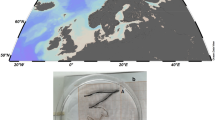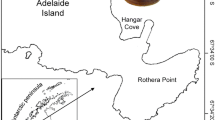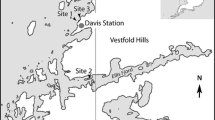Abstract
Quadrivisio bengalensis (Stebbing Records of Indian Museum, 1, 159–161, 1907), a eurythermal (26.5–32.2 °C) and euryhaline (0.10–26.2 psu) tropical species, makes a profound contribution as a fodder organism to the benthic biomass of tropical backwaters. Studies on life span, variations in broods, fecundity, sex ratio, brooding behaviour, brood stock assessment, growth rate, antennal segments as an index of growth, moulting frequency, mortality and starvation resistance of Q. bengalensis were made for the first time under controlled laboratory conditions of 12-h photo period for 252 days on 8 pairs of specimens (male and female) collected from the field and their successive broods. The life span of females was found to be higher (maximum 220 days) than males (maximum 175 days). Number of broods varied between 5 and 15, depending on the “status of the brood” (early or late). The maximum number of juveniles in a single brood was 24 and that by a single female over the entire life span was 211. The incubation time varied between 6 and 9 days and the duration of moults (8–18 days) was found to increase with the age of the animals. Maximum growth is usually attained by the offspring arising from the 5th to 7th broods. The 4th to 7th broods were the optimal broods for the maximum number of females attaining maturity. For broods 3 to 7 of the parental set, probability of extinction (ξ) calculated on applying stochastic branching process to generation studies for the first time showed an increasing trend with number of broods while a decreasing trend for ξ for 8th and 9th broods, with least ξ for broods 5 to 7 of the 5th, 6th and 7th generations, suggesting life span and fecundity rates as functions of the “brood status” (early or late). Whether it is true with higher crustaceans remains to be explored.








Similar content being viewed by others
References
Agnew, D. J., & Moore, P. G. (1986). The feeding ecology of two loittoral amphipods (Crustacea) Echinogammarus pirloti(Sexton and Spooner) and E.obtusatus. Journal of Experimental Marine Biology and Ecology, 103, 203–215.
Aravindakshan, P. N., Balasubramanian, T., Lalithambika Devi, C. B., Nair, K. K. C., Gopalakrishnan, T. C., Jayalakshmy, K. V., & Krishnan Kutty, M. (1992). Benthos and substratum characteristics of prawn culture fields in and around the Kochin Backwaters. Journal of the Marine Biological Association of India, 34(1&2), 203–217.
Baeza-Rojano, E., Domingues, P., José, M., Guerra-García, S. C., Noreña-Barroso, E., Caamal-Monsreal, C., & Rosas, C. (2013). Marine gammarids (Crustacea: Amphipoda): a new live prey to culture Octopus maya hatchlings. Aquaculture Research, 44(10), 1602–1612. https://doi.org/10.1111/j.1365-2109.2012.03169.x.
Barnard, K. H. (1935). Report on some Amphipoda Isopoda and Tanaidacea in the collection of the Indian Museum. Records of Indian Museum, 37, 279–319 Figs. 1-21.
Boxshall, G., & Jaume, D. (2013). Antennules and antennae in the crustacean. In L. Watling & M. Thiel (Eds.), Functional morphology and diversity (pp. 199–237). Oxford: Oxford University Press.
Buluheim, H. P. (1978). Interaction between genetic, external and parasitic factors in sex determination of the crustacean amphipod Gammarus dubeni Helgolander Wiss. Meeresunters., 31, 1–33.
Chandani, A., & Alan, A. M. (2004). Reproductive bionomics and life history traits of three Gammaridean amphipods, Cymudusa philosa, Savigny, Amphithoe lasipodus, Appadoo and Myers and Mallacoofa schelienbergi, Ledoyer from the tropical Indian Ocean(Mauritius). Acta Oceaologica, 26, 227–238.
Chevreux, E. (1913). Sur quelques interessantes especes d Amphipodes des parages de Monaco et des Peches pelagiques de lu “ Princesse Alice” et de I, Hirondelle II, dans la Mediterranee. Bullettin of Institute of Oceanography, Monaco, No. 262.
Chiba, S. (1998). A mathematical model for long term patterns of evolution: Effects of environmental stability and instability on macro-evolutionary patterns and mass extinctions. Paleobiology, 24(3), 336–348.
Chilton, C. (1925). Zoological results of a tour in the Far East. The Amphipoda of Tale Sap. Memories of Asiatic Society, Bengal, 6.
Cunha, M. R., Moreira, M. H., & Sorbe, J. C. (2000). Predicting amphipod Brood size variation in brackish environments: An emphirical model for Corophium multisetosum Stock. 1952. (Corophidae) in Ria de Aveiro NW Portugal. Journal of Experimental Marine Biology and Ecology, 248, 207–223.
E.Dahl 1973 - Antennal sensory hairs in Talitrid Amphipods ( crustacea), Acta Zoologica, Volume 54, issue 3, September 1973, pages 161-171
Feller, W. (1957). An introduction to probability theory and its applications (Vol. 1, pp. 1–572). New York: Willey.
Kinne, O. (1953). Zur Biologive und Physiologic von Gammarus duebeni Lillj. Zeitschrift für wissenschaftliche Zoologie, 157, 427–491.
Kinne, O. (1959). Ecological data on the amphipod, Gammarus duebeni. A monograph off. inst. Meeresforsch. Bremerhaven, 6, 177–202.
Kinne, O. (1961). Growth, moulting frequency, heart beat, number of eggs and incubation time in Gammarus zaddachi exposed to different environments. Crustaceana, 2, 26–35.
Kinne, O. (1970). Temperature: Invetebrates. In O. Kinne (Ed.), Marine Ecology (Vol. 1, pp. 407–514). Chichester: Wiley- Interscience.
Krishnan, L., & John, P. A. (1974). Observation on the breeding biology of Melita zeydanica Stebbing, a brackish water amphipod. Hydrobiologia, 44, 413–430.
Morino, H. (1978). Studies on the Talitridae (Amphipoda, Crustacea) in Japan. III Life history and breeding activity of Orchestia platensis Kroyer, Publication of the SETO, Marine Biology Laboratory, 24, 245–267.
Nair, K. N. (1959). The Amphipoda of the Madras Coast. Bullettin of the Madras Government. Natural History section, 6(3), 1–59 Plates 1-XVI.
Nair, K. K. C., & Anger, K. (1979a). Life cycle of Corophium insidiosum (Crustacea, Amphipoda) in laboratory culture. Helgoländer Wissenschaftliche Meeresuntersuchungen, 32, 279–294.
Nair, K. K. C., & Anger, K. (1979b). Experimental studies on the life cycle of Jassa falcata (Crustacea, amphipoda). Helgolander wiss. Meereswnters, 32, 444–452.
Nair, K. K. C., & Anger, K. (1980). A closed sea water flow through siphon systems for the cultivation and rearing of marine animals. Mahasagar, Bulletin National Institute of Oceanography, 13(2), 133–145.
Nair, K. K. C., Gopalakrishnan, T. C., Venugopal, P., George Peter, M., Jayalakshmy, K. V., & Rao, T. S. S. (1983). Population dynamics of estuarine amphipods in Kochin Backwaters. Marine Ecology Progress Series, 10, 289–295.
Nair, K. K. C., Gopalakrishnan, T. C.., Sankaranatrayanan, V. N., & Desai, B. N. (2006). A modified closed flow through siphon system for the cultivation of marine or estuarine organisms under simulated conditions. Patent No. 186483/15-9-2001. Sustain Fish- Proceedings of the international symposium on “ improved sustainability of fish production systems and appropriate technologies for utilization” ISBN-81-9032445-0-0, 2006, 156-171pp. School of Industrial Fisheries, Kochin University of Science and Technology, Kochin, India.
Nelson, W. G. (1980). Reproductive patterns of Gammaridean amphipods. Sarsia, 65, 61–71.
Nisha, P. A., Sheeba, P., Nair, K. K. C., & Achuthankutty, C. T. (2007). Life history and population dynamics of an estuarine amphipod Eriopisa chilkensis Chilton (Gammaridae). Estuarine, Coastal and Shelf Science, 74, 87–95.
Nityananda, M., Mayalagu, R., Junsun Sourav, K., Lyla, P. S., Khan, S. A., & Trilles, J. P. (2010). Biodiversity of brackish water amphipods(crustacean) in two estuaries, southeast coast of India. Environmental Monitoring and Assessment, 171, 471–486. https://doi.org/10.1007/s10661-009-1292-z.
Nott, M. P., Rogers, E., & Pimm, S. (1995). Modern Extinctions in the kilo death range. Current Biology, 5(1), 14–17.
Rojano, E. B., García, S., Garrido, D., José, M., & Guerra-García, P. D. (2010). Use of Amphipods as alternative prey to culture cuttle fish(Sepia officinalis) hatchlings. Aquaculture, 300, 243.
Sainte-Marie, B. (1991). A review of the reproductive bionomics of aquatic gammaridean amphipods: variation of life history traits with latitude, depth, salinity and super family. Hydrobiologia, 189, 189–227.
Sheader, M. (1978). Distribution and reproductive biology of Corophium insidiosum (Amphipoda) on the north east coast of England. Journal of Marine Biology Association (U.K.), 58, 585–596.
Shillenberg, A. (1938). Litorale Aamphipode des Tropischen Pazifiks. Kungliga Svenska Vetenskapsakademiens Handlingar Tredje ser, 16(6), 1–105 text figs. 1-48.
Shillenberg, A. (1942). Flohkrebse oder Amphipod Tierwelt Dtl. 40, 1-252.
Stebbing, T. R. R. (1907). The fauna of the brackish ponds at Port canning, lower Bengal, Part V definition of a new genus of Amphipoda and description of the typical species. Records of Indian Museum, 1, 159–161 Pl. VII.
Steele, D. H., & Steele, V. J. (1973). The biology of Gammrus (Crustacea, Amphipoda) in the north western Atlantic. VII. The duration of embryonic development in five species at various temperatures. Canadian Journal of Zoology, 51, 995–999.
Steele, D. H., & Steele, V. J. (1991). Morphological and environmental restraints on egg production in amphipods. In A. Wenner & A. Kuris (Eds.), Crustacean egg production (pp. 157–170). Rotterdam: A.A. Balkemma, Brookfield.
Stephensen, K. (1940). The amphipods of N. Norway and Spitzbengen with adjacent waters. Tromso Mus Skr, 3, 219–362.
Acknowledgements
The authors are extremely thankful to the Director, (CSIR) National Institute of Oceanography, Dona Paula, Goa for providing facilities to carry out this work and Scientist in Charge, (CSIR) NIO, Regional Centre, Kochi for all the supports. We are indebted to Professor (Dr.) Trevor Platt, Bedford Institute of Oceanography, Dartmouth, Nova Scotia, Canada, for his critical evaluation of the manuscript.
Author information
Authors and Affiliations
Corresponding author
Additional information
Publisher’s note
Springer Nature remains neutral with regard to jurisdictional claims in published maps and institutional affiliations.
Rights and permissions
About this article
Cite this article
Nair, K.K.C., Jayalakshmy, K.V. & Naveen Kumar, K.R. Generation studies on benthic amphipod—Quadrivisio bengalensis, Stebbing (Gammaridae) from the Kochin Estuary, Southwest coast of India. Environ Monit Assess 192, 68 (2020). https://doi.org/10.1007/s10661-019-7962-6
Received:
Accepted:
Published:
DOI: https://doi.org/10.1007/s10661-019-7962-6




